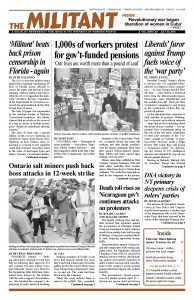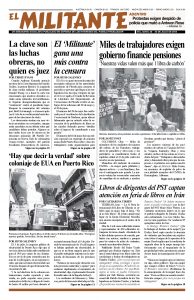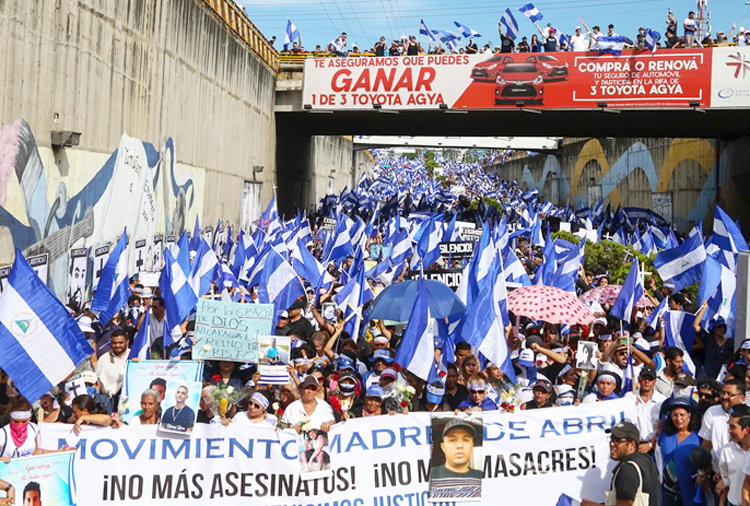The largely working-class and student protests that exploded against the government of President Daniel Ortega in Nicaragua in April continue nearly three months later with no sign of abating. Ortega has escalated deadly raids targeting opposition strongholds.
Demonstrations against Ortega began after supporters of the ruling capitalist party, the Sandinista National Liberation Front (FSLN), and police attacked retired workers demonstrating against government measures to make workers increase their contributions to the country’s social security pension fund and impose cuts on their benefits.
The government’s brutal repression of a student protest April 19 — leaving one person dead and dozens wounded — ignited more protests. Students occupied university campuses, and workers, small farmers and others set up barricades and roadblocks in towns and cities across the country.
In an attempt to quell the unrest, Ortega withdrew the social security cuts April 22, but by then protesters were calling for his and Vice President Rosario Murillo’s resignation, for an end to government repression, and prosecution of police and paramilitaries responsible for the killings.
Almost 300 people have been killed and over 2,000 wounded since the protests began, the vast majority government opponents. Hundreds have been arrested.
We were able to get a firsthand feel for the protests — and the brutal repression — from meeting and talking with protesters on our reporting trip to Nicaragua in June.
On July 13 a nationwide general strike emptied streets in Managua and much of the rest of the country, as businesses were shut down and public transportation stopped, heeding the call of a coalition of government opponents, including representatives of the demonstrating university students, workers, the main capitalist associations, small farmers groups and a variety of political formations.
Two days later car caravans of anti-government protesters drove to Masaya, a center of the uprising, as government paramilitary groups armed with assault rifles prepared to launch an attack there.
Gov’t calls massacre a ‘cleanup’
Ortega has moved to retain his grip on power using gangs of armed supporters, police dressed as civilians and former army officers to clear out barricades, campuses and roadblocks.
On July 10 Ortega’s forces stormed the cities of Jinotepe, Diriamba and Matagalpa, leaving 38 dead — 31 government opponents, four police and three paramilitaries — making it the bloodiest day so far since the protests began.
The government defended what they called a “cleanup operation,” saying it had acted to protect Nicaraguan families from “terrorist violence.” Vice President Murillo has cynically called these operations “Caravans of Peace.”
“The government wants to impose itself with bullets,” Francisca Ramírez told the press when we were there. She is a leader of small farmers and merchants who have protested against a 2013 law approving large-scale expropriation for a far-fetched plan to build a transcontinental canal through Nicaragua.
A “national dialogue” to attempt to mediate a solution to the political crisis was suspended May 23, when government representatives rejected demands for early presidential elections and walked out.
Ortega and Murillo have dismissed the massive popular discontent calling for their resignations. “The rules cannot be changed overnight because of the whim of a group of coup mongers,” said Ortega July 7.
He was speaking at an event held instead of an annual march to commemorate El repliegue, a “tactical retreat” carried out by popular forces led by the FSLN during the 1979 insurrection in Managua against the former U.S.-backed dictatorship of Anastasio Somoza. After 17 days of street combat, the then revolution-minded FSLN forces were forced to retreat to nearby Masaya, where a population in rebellion against the dictatorship welcomed them.
This year the march was called off because Masaya and many of the towns along the route were occupied with protests and barricades. After forcibly clearing the roadblocks, Ortega drove to Masaya accompanied by armed supporters July 13, the day of the general strike.
In 1979 the FSLN led a popular insurrection that overthrew the hated Somoza dictatorship, and established a government that mobilized workers and peasants in defense of their economic and political interests, increasingly encroaching on the prerogatives of Nicaraguan capitalists and imperialist interests. In the late 1980s, however, the FSLN backed away from that revolutionary course and was voted out of office in 1990. Today it is indistinguishable from other bourgeois parties.
Dwindling support for government
In 2006, after 16 years as an opposition party, and amid an economic and political crisis for working people, Ortega was elected president. His administration has continued the FSLN’s class-collaborationist policies of making alliances with sectors of the bourgeoisie and foreign investors. The capitalist development registered in Nicaragua has come at a real price for working people — the lowest minimum wage in the region; roughly 40 percent of the population lives in poverty; greater concentration of land in the hands of a few big landowners; encroachment on democratic and political rights; and widespread corruption.
After his election, Ortega won the support of many of the country’s poor, who benefited from social programs implemented by his government. But that backing has dwindled in the past few years as the government has imposed cuts. Support decreased even more after its brutal response to recent protests.
The opposition to Ortega comes largely from working-class and middle-class layers — including many that up until April considered themselves FSLN supporters — and from supporters of opposition parties, as well as workers who were part of the Sandinista revolution in the 1980s.
The main capitalist associations that had been allies of Ortega and his government as he implemented anti-working-class measures are now backing protests against him. While convinced it is not possible to go back to business-as-usual with Ortega remaining in power, these forces are divided on how fast he must go. Most are demanding elections be moved up to March 2019, a proposal backed by Washington, as well as Organization of American States Secretary General Luis Almagro. So far, Ortega refuses.
Concerned with foreign investors’ interests in Nicaragua and general stability in the region, Washington favors Ortega’s “orderly exit” from government. The deepening economic and social crisis the government’s policies have created for workers, farmers and youth, and its violent suppression of the protests, create conditions for the imperialist rulers in Washington to take advantage of.


